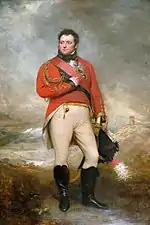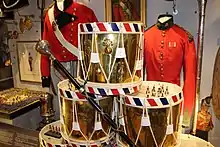Battle of Arroyo dos Molinos
The Battle of Arroyo dos Molinos took place on 28 October 1811 during the Peninsular War. An allied force under General Rowland Hill trapped and defeated a French force under General Jean-Baptiste Girard, forcing the latter's dismissal by the Emperor Napoleon. A whole French infantry division and a brigade of cavalry were destroyed as viable fighting formations.
| Battle of Arroyo dos Molinos | |||||||
|---|---|---|---|---|---|---|---|
| Part of the Peninsular War | |||||||
| |||||||
| Belligerents | |||||||
|
| |||||||
| Commanders and leaders | |||||||
|
|
| ||||||
| Strength | |||||||
| 6,000 | 9,000 | ||||||
| Casualties and losses | |||||||
|
1,000 killed or wounded 1,400 captured 3 guns lost | 80 killed, wounded or captured | ||||||
Background
In the middle of October, 1811 a French division under the command of Jean-Baptiste Girard crossed the River Guadiana at Mérida and campaigned in Northern Extremadura.[1] Major-General Rowland Hill consulted with Lieutenant-General Wellington and received permission to use his 2nd Division to pursue Girard. Upon learning that the French had halted at the village of Arroyo dos Molinos, near Alcuéscar, Hill force-marched his troops for three days in poor weather so as to catch the French before they moved on.
By the evening of the 27 October, Hill's forces had reached a point four miles from the French at Arroyo dos Molinos, and had the area around the enemy surrounded. The 71st (Highland) Regiment of Foot was ordered to occupy the village of Alcuéscar, three miles from Arroyo. During the night there was a violent hail-storm, and on the following morning the weather was still so foul that the French pickets on duty had their backs turned so as to gain some reprieve from the wind and rain - it was from this direction that Hill's forces attacked at dawn on the 28th.[2]

The French 34th and 40th Regiments suffered extremely heavy losses during the battle, although to Marshal Soult's relief the eagle standards of the two regiments were not lost to the British. He wrote to Napoleon: L'honneur des armes est sauvé; les Aigles ne sont pas tombés au pouvoir de l'ennemi. [The honour of the army is saved; the Eagles did not fall into the hands of the enemy.][3]
Long's cavalry charged, the 2nd Hussars King's German Legion particularly distinguishing themselves, and broke the French cavalry. Over 200 of them were captured plus three pieces of artillery.[4]
On 5 November a jubilant Hill (who would be made a Knight of the Bath for Arroyo dos Molinos) wrote to his sister;
I have time merely to inform you that on the morning of the 28th at daybreak I succeeded in surprising, attacking, and annihilating the French corps under General Girard at Arroyo dos Molinos. The enemy's force, when attacked, consisted of about 3,000 infantry, 1,600 cavalry and artillery. The result is the capture of one general (Bron), one colonel (the Prince d'Aremberg commander of the 27th Chasseurs), 35 lieutenant-colonels and inferior officers, 1,400 prisoners, and probably 500 killed. The others dispersed, having thrown away their arms; we have also got all the enemy's artillery, baggage, and magazines—in short, everything that belonged to the corps.[5]

The French eagles may "not have fallen into the hands of the enemy", however, the 34th [Cumberland] Regiment captured six side-drums of the 34e Régiment d'Infanterie together with the Drum-Major’s staff, which seized by Sergeant Moses Simpson of the 34th’s Grenadier Company. Included in the haul was the French grenadier company drum, the shell of which was emblazoned with three 'flaming grenade' emblems. The drums and drum majors staff are on display in Cumbria's Museum of Military Life Carlisle Castle.
Order of battle
British
In no order;
- 2nd Division
- First Brigade (Howard's)
- 9th (East Norfolk) Regiment of Foot[6]
- 24th (The 2nd Warwickshire) Regiment of Foot
- 50th (Queen's Own) Regiment of Foot
- One company, 5th Battalion, 60th (Royal American) Regiment of Foot
- 71st (Highland) Regiment of Foot[2]
- 92nd (Gordon Highlanders) Regiment of Foot[2]
- Third Brigade (Wilson's)
- 28th (North Gloucestershire) Regiment of Foot
- 2nd Battalion, 34th (Cumberland) Regiment of Foot
- 2nd Battalion, 39th (Dorsetshire) Regiment of Foot
- One company, 5th Battalion, 60th (Royal American) Regiment of Foot
- First Brigade (Howard's)
- Cavalry: 'D Brigade' (Long's)
- 9th Light Dragoons
- 13th Light Dragoons
- 2nd Hussars King's German Legion
French
- Division Girard (4000)[7]
- Brigade Dombrowski
- 34th Ligne Infantry Regiment (3 battalions)
- 40th Ligne Infantry Regiment (3 battalions)
- Brigade Bron
- 27th Chasseurs à Cheval (light cavalry)
- 10th Hussars
- 20th Dragoons
- Brigade Dombrowski
Artillery: one 8 pdr, one 4pdr, one Lgt Howitzer.
Citations
- Robinson. Wellington's Campaign. p. 201.
- Robinson. Wellington's Campaign. p. 202.
- Fraser. The War Drama of the Eagles. p. 262.
- Beamish, pp. 22-24
- Stanley. The Life of Lord Hill. p. 172.
- Cannon. Historical Record of the Ninth. p. 134.
- Smith, p 368
References
- Beamish, N.L, History of the King's German Legion, Vol. II, London (1837).
- Cannon, Richard (1848). Historical Record of the Ninth, or East Norfolk, Regiment of Foot. London: Parker, Furnivall, & Parker.
- Fraser, Edward (1912). The War Drama of the Eagles. London: John Murray.
- Gardyne, Lt.-Col. C. Greenhill (1901). The Life of a Regiment: the History of the Gordon Highlanders from its Formation in 1794 to 1816. Edinburgh: David Douglas.
- Robinson, Charles Walker (1907). Wellington's Campaigns, Peninsula-Waterloo, 1808-15: Also Moore's Campaign of Corunna. London: Hugh Rees, Ltd.
- Smith, Digby. The Napoleonic Wars Data Book. London: Greenhill, 1998. ISBN 1-85367-276-9
- Stanley, Rev. Edwin (1845). The Life of Lord Hill. London: John Murray.
- Sánchez, María (Director); Bote, Daniel (Director) (2015). El disparo que rompe el silencio. Arroyomolinos 1811 [The shot that breaks the silence. Arroyomolinos 1811.] (Youtube) (in Spanish and English). ISAN:0000-0003-DB83-0000-L-0000-0000-B.